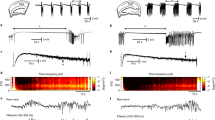Abstract
Epileptic seizures are characterized by a rich dynamic spectrum consisting of excessive, abnormal and synchronized firing of neuron ensembles. Such abnormal firing has been quantitatively characterized via power laws in neural avalanches. The term “neural avalanche” has been used to illustrate the excessively amplified neural firing patterns that lead to epileptic seizures. The pattern of amplified firing in neural avalanches betrays a modular signature in the spread of activation across cortical minicolumns. According to this modular approach of epilepsy, the excessive amplification of neural firing in a cortical minicolumn results from a defect within the “inhibitory curtain” surrounding the pyramidal cells. The functional basis of this approach provides insights into potential clinical interventions.
Access this chapter
Tax calculation will be finalised at checkout
Purchases are for personal use only
Similar content being viewed by others
References
Anderson NR, Blakely T, Brunner P et al (2013) High-frequency spectral changes in Dorsolateral Prefrontal Cortex for potential neuoroprosthetics. In: Conference proceedings of the IEEE engineering in medicine and biology society 2013, pp 2247–2250
Bak P (1996) How nature works: the science of self-organized criticality. Copernicus, New York
Bak P, Tang C, Wiesenfeld K (1987) Self-organized criticality: an explanation of the 1/f noise. Phys Rev Lett 59:381–384
Bauer PR, Kalitzin S, Zijlmans M et al (2014) Cortical excitability as a potential clinical marker of epilepsy: a review of the clinical application of transcranial magnetic stimulation. Int J Neural Syst 24(2):1430001. doi:10.1142/S0129065714300010
Beggs JM (2008) The criticality hypothesis: how local cortical networks might optimize information processing. Phil Trans R Soc A 366(1864):329–343
Beggs JM, Plenz D (2003) Neuronal avalanches in neocortical circuits. J Neurosci 23:11167–11177
Bennewitz MF, Saltzman WM (2009) Nanotechnology for delivery of drugs to the brain for epilepsy. Neurotherapeutics 6(2):323–336
Berg AT, Brkovic SF, Brodie MJ et al (2010) Revised terminology and concepts for organization of seizures and epilepsies: report of the ILAE commission on classification and terminology, 2005–2009. Epilepsia 51(4):676–685
Blackspear M, Roberts JA, Terry JR et al (2006) A unifying explanation of primary generalized seizures through nonlinear brain modeling and bifurcation analysis. Cereb Cortex 16(9):1296–1313
Buxhoeveden D, Casanova M (2002) The minicolumn Hypothesis in neuroscience. Brain 125:935–951
Buzsaki G, Horvath Z, Urioste R et al (1992) High-frequency network oscillation in the hippocampus. Science 256:1025–1027
Casanova MF, Trippe J, Switala A (2007) A temporal continuity to the vertical organization of the human neocortex. Cereb Cortex 17(1):130–137
Chang BS, Lowenstein DH (2003) Epilepsy. N Engl J Med 349(13):1257–1266. doi:10.1056/NEJMra022308, PMID 14507951
Chrobak JJ, Buzsaki G (1996) High-frequency oscillations in the output of the hippocampal–entorhinal axis of the freely behaving rat. J Neurosci 16:3056–3066
Cossette P, Liu L, Brisebois K et al (2002) Mutation of GABRA1 in an autosomal dominant form of juvenile myoclonic epilepsy. Nat Genet 31(2):184–189
Csicsvari J, Hirase H, Czurko A et al (1999) Oscillatory coupling of hippocampal pyramidal cells and interneurons in the behaving rat. J Neurosci 19(1):274–287
Curry DJ, Gowda A, McNichols RJ et al (2012) MR-guided stereotactic laser ablation of epileptogenic foci in children. Epilepsy Behav 24(4):408–414
Cyberonics (2014) Cyberonics announces CE mark approval of the aspireSR™ generator for VNS therapy®. http://ir.cyberonics.com/releasedetail.cfm?ReleaseID=826981 Accessed 22 July 2014
Enatsu R, Piao Z, O'Connor T et al (2012) Cortical excitability varies upon ictal onset patterns in neocortical epilepsy: a cortico-cortical evoked potential study. Clin Neurophysiol 123:252–260
Expert P, Lambiotte R, Chialvo DR et al (2010) Self-similar correlation function in brain resting-state functional magnetic resonance imaging. J R Soc Interface 8(57):472–479
Fisher RS, van Emde BW, Blume W et al (2005) Epileptic seizures and epilepsy: definitions proposed by the International League Against Epilepsy (ILAE) and the International Bureau for Epilepsy (IBE). Epilepsia 46:470–472
Fisher RS, Acevedo C, Arzimanoglou A et al (2014) A practical clinical definition of epilepsy. Epilepsia 55(4):475–482
Fox MD, Raichle ME (2007) Spontaneous fluctuations in brain activity observed with functional magnetic resonance imaging. Nat Rev Neurosci 8(9):700–711
Giresh E, Plenz D (2008) Neuronal avalanches organize as nested theta and beta/gamma-oscillations during development of cortical layer 2/3. Proc Natl Acad Sci U S A 105(21):7576–7581
Haimovici A, Tagliazucchi E, Balenzuela P et al (2013) Brain organization into resting state networks emerges at criticality on a model of the human connectome. Phys Rev Lett 110:178101
Heck CN, King-Stephens D, Massey AD et al (2014) Two-year seizure reduction in adults with medically intractable partial onset epilepsy treated with responsive neurostimulation: final results of the RNS System Pivotal trial. Epilepsia 55(3):432–441
Hobbs JP, Smith JL, Beggs JM (2010) Aberrant neuronal avalanches in cortical tissue removed from juvenile epilepsy patients. J Clin Neurophysiol 27:380–386
Hsu D, Beggs JM (2006) Neuronal avalanches and criticality: a dynamical model for homeostasis. Neurocomputing 69:1134–1136
Hsu D, Tang A, Hsu M et al (2007) Simple spontaneously active Hebbian learning model: homeostasis of activity and connectivity, and consequences for learning and epileptogenesis. Phys Rev E Stat Nonlin Soft Matter Phys 76(4 Pt 1):041909
Hsu D, Chen W, Hsu M et al (2008) An open hypothesis: is epilepsy learned, and can it be unlearned? Epilepsy Behav 13(3):511–522
Hsu WY, Cheng CH, Lin MW et al (2011) Antiepileptic effects of low frequency repetitive transcranial magnetic stimulation: a meta-analysis. Epilepsy Res 96(3):231–240
Iwasaki M, Enatsu R, Matsumoto R et al (2010) Accentuated cortico-cortical evoked potentials in neocortical epilepsy in areas of ictal onset. Epileptic Disord 12(4):292–302. doi:10.1684/epd.2010.0334
Johnson LA, Blakely T, Hermes D et al (2012) Sleep spindles are locally modulated by training on a brain-computer interface. Proc Natl Acad Sci U S A 109(45):18583–18588
Klaus A, Yu S, Plenz D (2011) Statistical analyses support power law distributions found in neuronal avalanches. PLoS ONE 6(5):e19779. doi:10.1371/journal.pone.0019779
Kwan P, Brodie MJ (2000) Early identification of refractory epilepsy. N Engl J Med 342:314–319
Levina A, Herrmann JM, Geisel T (2005) Dynamical synapses give rise to a power law distribution of neuronal avalanches. Neural Information Processing Systems (NIPS). Adv Neural Inf Process Syst 18:771–778
Levinshtein M, Kostamovaara J, Vainshtein S (2005) Breakdown phenomena in semiconductors and semiconductor devices. World Scientific, Singapore
Lüders H, Acharya J, Baumgartner C et al (1998) Semiological seizure classification. Epilepsia 39(9):1006–1013
Lukasiuk K, Becker AJ (2014) Molecular biomarkers of epileptogenesis. Neurotherapeutics 11(2):319–323
Margolina A, Herrmann HJ, Stauffer D (1982) Size of largest and second-largest cluster in random percolation. Phys Lett 49A:73–75
McPhee SJ, Hammer GD (2010) Pathophysiology of disease: an introduction to clinical medicine, 6th edn. McGraw-Hill Medical, New York
Meisel C, Storch A, Hellmeyer-Elgner S et al (2012) Failure of adaptive self-organized criticality during epileptic seizure attacks. PLoS Comput Biol 8(1):1–8
Menzler K, Thiel P, Hermsen A et al (2011) The role of underlying structural cause for epilepsy classification: clinical features and prognosis in mesial temporal lobe epilepsy caused by hippocampal sclerosis versus cavernoma. Epilepsia 52(4):707–711
Mountcastle VB (1957) Modality and topographic properties of single neurons of cat's somatic sensory cortex. J Neurophysiol 20(4):408–434
Mountcastle VB (1997) The columnar organization of the neocortex. Brain 120:701–722
National Institute for Health and Clinical Excellence (2012) The epilepsies: the diagnosis and management of the epilepsies in adults and children in primary and secondary care. National Clinical Guideline Centre, London, pp 21–28
Nunes VD, Sawyer L, Neilson J et al (2012) Diagnosis and management of the epilepsies in adults and children: summary of BMJ. BMJ 344:e281. doi: 10.1136/bmj.e281
Opris I (2013) Inter-laminar microcircuits across the neocortex: repair and augmentation. frontiers. In: Lebedev MA, Opris I, Casanova MF (ed) Systems neuroscience research topic: “Augmentation of brain function: facts, fiction and controversy”. doi:10.3389/fnsys.2013.00080
Opris I, Casanova MF (2014) Prefrontal cortical minicolumn: from executive control to disrupted cognitive processing. Brain. doi:10.1093/brain/awt359
Opris I, Hampson RE, Stanford TR et al (2011) Neural activity in frontal cortical cell layers: evidence for columnar sensorimotor processing. J Cogn Neurosci 23(6):1507–1521. doi:10.1162/jocn.2010.21534
Opris I, Fuqua JL, Huettl PF et al (2012a) Closing the loop in primate prefrontal cortex: inter-laminar processing. Front Neural Circuits 6:88. doi:10.3389/fncir.2012.00088
Opris I, Hampson RE, Gerhardt GA et al (2012b) Columnar processing in primate pFC: evidence for executive control microcircuits. J Cogn Neurosci 24(12):2334–2347
Opris I, Santos L, Gerhardt GA et al (2013) Prefrontal cortical microcircuits bind perception to executive control. Sci Rep 3:2285. doi:10.1038/srep02285
Pathan SA, Jain GK, Akhter S et al (2010) Insights into the novel three ‘D’s of epilepsy treatment: drugs, delivery systems and devices. Drug Discov Today 15(17–18):717–732
Plenz D (2012) Neuronal avalanches and coherence potentials. Eur Phys J Spec Top 205(1):259–301
Ramsey RE, Uthman B, Ben-Menachem E et al (1991) Efficacy of vagal nerve stimulation in partial seizueres: double blind comparison of two stimulus paradigms. Epilepsia 32(suppl):90–91
Rosenow F, Lüders HO (2001) Presurgical evaluation of epilepsy. Brain 124:1683–1700
Royer S, Pare D (2003) Conservation of total synaptic weight through balanced synaptic depression and potentiation. Nature 422(6931):518–522
Schevon CA, Trevelyan AJ, Schroeder CE et al (2009) Spatial characterization of interictal high frequency oscillations in epileptic neocortex. Brain 132(Pt 11):3047–3059
Seo D, Carmena JM, Rabaey JM et al (2013) Neural dust: an ultrasonic, low power solution for chronic brain-machine interfaces, Cornell University Library, arXiv:1307.2196 [q-bio.NC]
Shepherd G, Grillner S (2010) Handbook of brain microcircuits. Oxford University Press, Oxford
Shew W, Plentz D (2013) The functional benefits of criticality in the cortex. Neuroscientist 19:88–100
Sole RV, Valverde S (2008) Spontaneous emergence of modularity in cellular networks. J R Soc Interface 5:129–133
Staba RJ, Stead M, Worrell GA (2014) Electrophysiological biomarkers of epilepsy. Neurotherapeutics 11(2):334–346. doi:10.1007/s13311-014-0259-0
Stead M, Bower M, Brinkmann BH et al (2010) Microseizures and the spatiotemporal scales of human partial epilepsy. Brain 133(9):2789–2797. doi:10.1093/brain/awq190
Szentagothai J (1975) The module-concept in cerebral cortex architecture. Brain Res 95:475–496
Tovar-Spinoza Z, Carter D, Ferrone D et al (2013) The use of MRI-guided laser-induced thermal ablation for epilepsy. Childs Nerv Syst 29(11):2089–2094
Turrigiano GG, Nelson SB (2000) Hebb and homeostasis in neuronal plasticity. Curr Opin Neurobiol 10:358–364
Vaessen MJ, Jansen JFA, Braakman HMH et al (2014) Functional and structural network impairment in childhood frontal lobe epilepsy. PLoS ONE 9(3):e90068
Varela F, Lachaux JP, Rodriguez E et al (2001) The brainweb: phase synchronization and large-scale integration. Nat Rev Neurosci 2:229–239
Wallace GG, Higgins MJ, Moultonand SE et al (2012) Nanobionics: the impact of nanotechnology on implantable medical bionic devices. Nanoscale 4:4327–4347
Wang S (2013) Online seizure prediction using an adaptive learning approach. IEEE Trans Knowl Data Eng 25(12):2854–2866
Worrell GA, Cranstoun SD, Echauz J et al (2002) Evidence for self-organized criticality in human epileptic hippocampus. Neuroreport 13:2017–2021
Wu JJS, Chang WP, Shih HC et al (2014) Cingulate seizure-like activity reveals neuronal avalanche regulated by network excitability and thalamic inputs. BMC Neurosci 15(3):1–17
Yang H, Shew WL, Roy R et al (2012) Maximal variability of phase synchrony in cortical networks with neuronal avalanches. J Neurosci 32(3):1061–1072. doi:10.1523/JNEUROSCI. 2771-11.2012
Yua N, Liub H, Dia Q (2013) Modulation of immunity and the inflammatory response: a new target for treating drug-resistant epilepsy. Curr Neuropharmacol 11:114–127
Zijlmans M, Jiruska P, Zelmann R et al (2012) High-frequency oscillations as a new biomarker in epilepsy. Ann Neurol 71(2):169–178
Acknowledgments
Ana Ciurea was supported by the strategic grant POSDRU/159/1.5/S/133652, “Integrated system to improve the quality of doctoral and postdoctoral research in Romania and promotion of the role of science in society” cofinanced by the European Social Found within the Sectorial Operational Program Human Resources Development 2007–2013.
Author information
Authors and Affiliations
Corresponding author
Editor information
Editors and Affiliations
Rights and permissions
Copyright information
© 2015 Springer Science+Business Media Dordrecht
About this chapter
Cite this chapter
Ciurea, A. et al. (2015). Modular Signatures and Neural Avalanches in Epileptic Brain Networks. In: Casanova, M., Opris, I. (eds) Recent Advances on the Modular Organization of the Cortex. Springer, Dordrecht. https://doi.org/10.1007/978-94-017-9900-3_15
Download citation
DOI: https://doi.org/10.1007/978-94-017-9900-3_15
Publisher Name: Springer, Dordrecht
Print ISBN: 978-94-017-9899-0
Online ISBN: 978-94-017-9900-3
eBook Packages: Biomedical and Life SciencesBiomedical and Life Sciences (R0)




